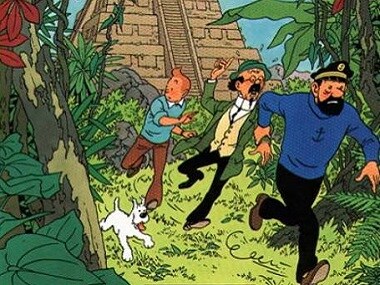
Gangsters, Cowboys, Indians and the Big Apple await Tintin when he travels across the Atlantic to America. His attempts to research his story are put to the test by the Bolsheviks and Moscow’s secret police … Please share them below in the “Leave a Reply” section.Accompanied by his dog Snowy, Tintin leaves Brussels to go undercover in Soviet Russia. We’d really like to hear your experiences of the subject(s) featured in this post. If you liked this post please “Like” and share it with your friends. Rather than the expense of using a framing service why not select the following perfect frames to display your posters by clicking the AMAZON link Having read the books you may want to add to your poster collection with the following three iconic posters – click the Amazon link that follows to buy them If you’d like to buy the final Tintin story “Tintin and the Alph-Art” – as started by Hergé please click the following AMAZON link Tintin and Alph-Art (The Adventures of Tintin) If you’d like to buy a collection of the 23 Tintin story books published during Hergé’s life please click the following AMAZON link The Tintin Collection (The Adventures of Tintin – Compact Editions) In 2006, the Dalai Lama presented Tibet’s Light of Truth Award to the Foundation in memory of Tintin and the impact of “Tintin in Tibet”. The Foundation has received many awards for Tintin. Magazine and retail outlets have bolstered the Foundations earning to great success.
THE ADVENTURES OF TINTIN BY HERGÉ TV
Plays, TV series, films and video games have been made based on Tintin’s exploits. The intellectual property in Hergé’s work passed to his foundation on his death and the underlying copyrights and associated merchandising rights have continued to be of great value. The primary coloured graphics, elaborately researched stories and instantly recognisable layout and text has ensured continuity across the stories and has preserved an enduring affection for the cast amongst old and young reader. Great characterisation, expressive drawing, adventure and simple humour combined with a more sophisticated satire and socio-political critique has ensured that the “Adventures of Tintin” have charmed readers for many years. In 1950 frustrated by the demands of employment Hergé established “Studios Hergé” which was disbanded on his death. The Nazi occupation of Belgium forced the closure of his employer and Le Soir started to serialise the cartoon strip. Tintin first appeared on 10 th January 1929 in a children’s supplement to the Brussels’ newspaper “Le Vingtième Siècle” for whom Remi worked as an illustrator.

It is said that sales of the books exceeded 250m copies and the books were translated into more than 75 languages. He was completing a 24 th entitled “Tintin and the Alp-Art” at the time of his death that was posthumously published in 1986. George Remi – known by the pen name “Hergé” – was born in Belgium in 1907 and between 1929 and his death in 1983 wrote 23 Tintin books. Despite more recent accusation of racism, these charming storybooks were first published against a background of the rise of the Nazis and latterly their occupation of much of Europe. Many will be familiar with the imagery of the characters, Tintin – a young Belgian reporter, Snowy, his terrier – called “Milou” in the earlier French language versions – the cynical Captain Haddock, the brilliant and partially deaf Physicist, Professor Calculus and the bumbling detectives Thomson & Thomson.

In similar locations the framed posters of Tintin’s adventures featuring the brightly coloured graphics and highly engaging and recognisable characters have found a home. Many UK homes have basements, attics, snugs and Man Caves where the walls are decked with a combination of painted adverts for motor races, rail travel, skiing or beach scenes from a bygone era intended to entice Edwardian tourists to visit. The balance of gallery space is taken up with prints from fine artists, some local and the framed covers of the books depicting the iconic “The Adventures of Tintin”. The Gallery is a throve of entirely appropriate greetings cards, thoughtful gifts and at Christmas it has a wall in the rear of the gallery space devoted to fine German advent calendars with small pictures concealed behind perforated and numbered squares – no wrapped chocolate surprise needed. The streets of Mayfair W1 are the sadder for its loss but SW7 still counts the Gallery as a treasured neighbour. There used to be a larger sister gallery over several floors in Cork Street (Mayfair) but with the pressure on property and the need to accommodate the Hedge Fund community, the business model of The Gallery was sadly unsustainable. Should you find yourself in London’s South Kensington next to the Underground station on the pedestrian-only Thurloe Street there’s is a small remnant of a larger art gallery chain called “The Medici Gallery”.


 0 kommentar(er)
0 kommentar(er)
